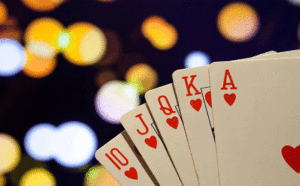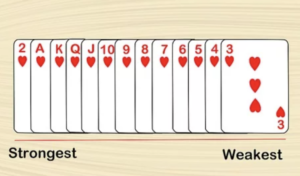
Card games are always a great way to pass time and have fun with friends. 13 is a card game that’s played in groups of four where each player gets 13 cards from the deck (hence the name of the game). The mechanics of this game vary depending on who you’re playing it with and where you play it. Nonetheless, 13 deploys mechanics that create a dynamic that makes it enjoyable for almost all individuals who play it.
The basic mechanics of this game stem from the ranking of the cards. All the cards and suits are ranked from weakest to strongest. 3 is the weakest card and 2 is the highest card. In terms of suits, the strongest suit is hearts followed by diamonds, clubs, and spades, within the same card. For example, a 3 of hearts beats a 3 of diamonds, but a 3 of hearts is beaten by a 4 of spades.

The objective of the game is to get rid of your hands as quickly as possible. Each round, players compete against each other by placing a card that beats the previous (highest) card on the table (presumably placed by the previous player) until you’ve placed all your cards on the table. There are different tricks one can execute to get rid of their hands quickly which I won’t cover here.
The dynamics of this game that draw us in and keep us engaged is derived from the opponent play. You are playing against the three other players which created a competitive environment. The ranking of the game restricts the movement of the players. You can’t place card(s) that are ranked lower than the previous card, which makes you play strategically to take advantage of the ranking but also moves you towards winning. Additionally, the player that placed the last (highest) card chooses the order of the cards for the next round and thus has an advantage over the other players. All of these mechanics create the game’s dynamic which draws us in and keeps us engage.
Speaking of engagement, there are three aesthetics of 13 that make it fun/enjoyable: competition, submission/abnegation, and challenge. The nature of the opponent play creates a competitive atmosphere, which is a big reason people like myself enjoy 13 so much. As a card game, it’s easy to play on the go, with close friends or complete strangers. Thus, this flexibility and design to be a pass-time game make it fun. Finally, the challenge of 13 comes from the objective of the game: get rid of your hands as quickly as possible. This challenges you to be strategic about your moves and know how to read the other players in order to make the best move in each round.
As you can see, the mechanics of 13 establish dynamics that are guaranteed to make it fun for players. This is definitely the case for me.


